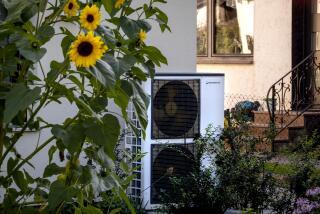Costs Make Energy-Independent Homes More Feasible : Environment: The idea is attractive to those who want to ‘live lightly on the planet,’ as well as those who live in remote areas and those who value their independence.
- Share via
SAVAGE ISLAND, Vt. — Down near the dock there’s a solar panel that runs the pump that carries water up to the house. Up the hill is another one that runs just about everything else.
“I’m not a joiner, really,” said 68-year-old Ted Riehle, who lives on a Lake Champlain island about a mile off a remote landing reached by a dirt road.
It would have cost tens of thousands of dollars to run a power line to Savage Island, so this non-joiner decided to go it alone--joining a growing number of Americans who are getting “off the grid,” in utility jargon, and are parting ways with their power companies.
The solar panels convert sunlight into electricity that is stored in nickel-cadmium batteries in the basement of Riehle’s home, built in 1988. He heats with wood cut on his 207-acre island. Propane is used for cooking and as a backup for the solar hot water system.
The solar setup wasn’t cheap, costing more than $20,000. A laughing Riehle guesses that it will pay for itself in absent monthly electric bills “on my 165th birthday.”
But the prices of solar and other alternative energy technologies have come down significantly even in the five years since Riehle built his home. That applies both to the photovoltaic cells that generate electricity and to space heating and hot water systems.
Competition and advances in technology have cut the cost of solar-generated electricity to less than a tenth of its cost in the mid-1970s. Solar hot water systems are selling for as little as $2,200, an amount a family using a typical $50 a month worth of hot water will recoup in less than four years.
And two notable events may boost the trend. One hundred fifty solar-powered houses around the country were opened to public inspection on Saturday.
And late this year, one of the nation’s largest home builders, DKM Building Enterprises of Muncy, Pa., is expected to begin marketing a line of homes--everything from ranches to executive colonials--that will be heated and powered mainly or exclusively with solar energy.
Lyle Rawlings, a New Jersey solar energy consultant who is working with DKM, said that company’s homes begin with lower costs because they are factory-built, or modular, homes.
He said the homes are expected to sell for between $125,000 and $170,000, depending on the price of land. When energy costs are factored into overall housing costs, he said, the homes will be quite affordable.
David Palumbo of the Vermont-based Independent Power & Light Co. said most homeowners who are considering converting their houses to solar power would find it cheaper to sign up with the local utility.
Outfitting a home with solar panels, batteries to store the power for a cloudy day and inverters to change battery-produced direct current power to the alternating current electricity used in household circuits now typically costs between $10,000 and $20,000, Palumbo said.
But political and environmental considerations often enter into the equation. People suspicious of nuclear power, coal-burning generators and the big corporations that build them are prime candidates for energy independence, Palumbo said.
In his upcoming new book, “The Independent Home,” author Michael Potts writes that “Independent homeowners enjoy the deeper satisfaction of knowing they are directly and creatively involved in the goal of living lightly on the planet.”
Riehle, a former Republican state representative who voted for President George Bush last year, seemed less interested in the environmental and political correctness of it all. “You don’t have to be a bearded hippie with love beads to get off the grid.”
The self-described “gadget man” said of the nuclear power industry: “I’m not anti-nuke at all. In fact, I think they’ve gotten a bum rap.”
He added: “I just like the idea of being independent. Maybe that’s why I bought an island.”
One theme being pushed by solar and alternative energy advocates is the idea that “living lightly” does not mean doing without.
Riehle’s 2 1/2-story island home is fully equipped with televisions, radios, electric lights, washer and dryer and refrigerator. The growth in the number of off-the-grid homes has closely followed the development of low-wattage light bulbs and energy-saving appliances.
For instance, both Riehle and Palumbo have refrigerator-freezers made by a California firm called Sunfrost Inc. The units are highly insulated and their compressors, rather than being on the bottom or in back as in a conventional refrigerator, are on top. That allows the heat from the compressor to rise away from the refrigerator, meaning less need for cooling energy.
Palumbo said his refrigerator uses about 20% of the energy that a conventional refrigerator does.
One drawback: It costs about $2,500.
More to Read
Inside the business of entertainment
The Wide Shot brings you news, analysis and insights on everything from streaming wars to production — and what it all means for the future.
You may occasionally receive promotional content from the Los Angeles Times.










